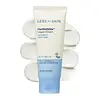What's inside
What's inside
 Key Ingredients
Key Ingredients

 Benefits
Benefits

 Concerns
Concerns

 Ingredients Side-by-side
Ingredients Side-by-side

Dimethicone 1%
EmollientWater
Skin ConditioningHydrogenated Polyisobutene
EmollientGlycerin
HumectantButyrospermum Parkii Butter
Skin ConditioningPanthenol
Skin ConditioningAluminum Starch Octenylsuccinate
AbsorbentButylene Glycol
HumectantPropanediol
SolventCetyl PEG/PPG-10/1 Dimethicone
EmulsifyingTrihydroxystearin
Skin ConditioningZinc Gluconate
Skin ConditioningMadecassoside
AntioxidantManganese Gluconate
Skin ConditioningSilica
AbrasiveAluminum Hydroxide
EmollientMagnesium Sulfate
Disodium EDTA
Copper Gluconate
Skin ConditioningCitric Acid
BufferingAcetylated Glycol Stearate
EmollientPolyglyceryl-4 Isostearate
EmulsifyingTocopherol
AntioxidantPentaerythrityl Tetra-Di-T-Butyl Hydroxyhydrocinnamate
AntioxidantSodium Benzoate
MaskingPhenoxyethanol
PreservativeChlorhexidine Digluconate
AntimicrobialTitanium Dioxide
Cosmetic ColorantDimethicone 1%, Water, Hydrogenated Polyisobutene, Glycerin, Butyrospermum Parkii Butter, Panthenol, Aluminum Starch Octenylsuccinate, Butylene Glycol, Propanediol, Cetyl PEG/PPG-10/1 Dimethicone, Trihydroxystearin, Zinc Gluconate, Madecassoside, Manganese Gluconate, Silica, Aluminum Hydroxide, Magnesium Sulfate, Disodium EDTA, Copper Gluconate, Citric Acid, Acetylated Glycol Stearate, Polyglyceryl-4 Isostearate, Tocopherol, Pentaerythrityl Tetra-Di-T-Butyl Hydroxyhydrocinnamate, Sodium Benzoate, Phenoxyethanol, Chlorhexidine Digluconate, Titanium Dioxide
Water
Skin ConditioningPropanediol
SolventPanthenol
Skin ConditioningCaprylic/Capric Triglyceride
MaskingCetyl Ethylhexanoate
Emollient1,2-Hexanediol
Skin ConditioningHydroxyethyl Urea
HumectantPolyglyceryl-6 Stearate
EmollientEthylhexyl Olivate
Skin ConditioningPentaerythrityl Tetraisostearate
EmollientOlea Europaea Fruit Oil
MaskingBeta-Glucan
Skin ConditioningHydrolyzed Corn Starch
HumectantDioscorea Japonica Root Extract
Skin ConditioningPhytosteryl/Isostearyl/Cetyl/Stearyl/Behenyl Dimer Dilinoleate
Skin ConditioningVegetable Oil
Skin ConditioningPolyglyceryl-6 Behenate
Emulsion StabilisingCetearyl Alcohol
EmollientPolyglyceryl-5 Stearate
EmulsifyingButyrospermum Parkii Butter
Skin ConditioningArginine
MaskingEthylhexylglycerin
Skin ConditioningDisodium EDTA
Sodium Hyaluronate
HumectantCetearyl Olivate
Sorbitan Olivate
EmulsifyingHydrogenated Lecithin
EmulsifyingSodium Acrylates Copolymer
Polyglyceryl-4 Oleate
EmulsifyingPolyacrylate Crosspolymer-6
Emulsion StabilisingCarbomer
Emulsion StabilisingXanthan Gum
EmulsifyingSucrose
HumectantGlyceryl Glucoside
HumectantGlycerin
HumectantSodium Acrylic Acid/Ma Copolymer
Butylene Glycol
HumectantDipropylene Glycol
HumectantCaprylyl Glycol
EmollientWater, Propanediol, Panthenol, Caprylic/Capric Triglyceride, Cetyl Ethylhexanoate, 1,2-Hexanediol, Hydroxyethyl Urea, Polyglyceryl-6 Stearate, Ethylhexyl Olivate, Pentaerythrityl Tetraisostearate, Olea Europaea Fruit Oil, Beta-Glucan, Hydrolyzed Corn Starch, Dioscorea Japonica Root Extract, Phytosteryl/Isostearyl/Cetyl/Stearyl/Behenyl Dimer Dilinoleate, Vegetable Oil, Polyglyceryl-6 Behenate, Cetearyl Alcohol, Polyglyceryl-5 Stearate, Butyrospermum Parkii Butter, Arginine, Ethylhexylglycerin, Disodium EDTA, Sodium Hyaluronate, Cetearyl Olivate, Sorbitan Olivate, Hydrogenated Lecithin, Sodium Acrylates Copolymer, Polyglyceryl-4 Oleate, Polyacrylate Crosspolymer-6, Carbomer, Xanthan Gum, Sucrose, Glyceryl Glucoside, Glycerin, Sodium Acrylic Acid/Ma Copolymer, Butylene Glycol, Dipropylene Glycol, Caprylyl Glycol
 Reviews
Reviews

Ingredients Explained
These ingredients are found in both products.
Ingredients higher up in an ingredient list are typically present in a larger amount.
Butylene Glycol (or BG) is used within cosmetic products for a few different reasons:
Overall, Butylene Glycol is a safe and well-rounded ingredient that works well with other ingredients.
Though this ingredient works well with most skin types, some people with sensitive skin may experience a reaction such as allergic rashes, closed comedones, or itchiness.
Learn more about Butylene GlycolThis ingredient is also known as shea butter. It is an effective skin hydrator and emollient.
Emollients help soothe and soften your skin. It does this by creating a protective film on your skin. This barrier helps trap moisture and keeps your skin hydrated. Emollients may be effective at treating dry or itchy skin.
Shea butter is rich in antioxidants. Antioxidants help fight free-radicals, or molecules that may harm the body. It is also full of fatty acids including stearic acid and linoleic acid. These acids help replenish the skin and keep skin moisturized.
While Shea Butter has an SPF rating of about 3-4, it is not a sunscreen replacement.
Shea butter may not be fungal acne safe. We recommend speaking with a professional if you have any concerns.
Learn more about Butyrospermum Parkii ButterDisodium EDTA plays a role in making products more stable by aiding other preservatives.
It is a chelating agent, meaning it neutralizes metal ions that may be found in a product.
Disodium EDTA is a salt of edetic acid and is found to be safe in cosmetic ingredients.
Learn more about Disodium EDTAGlycerin is already naturally found in your skin. It helps moisturize and protect your skin.
A study from 2016 found glycerin to be more effective as a humectant than AHAs and hyaluronic acid.
As a humectant, it helps the skin stay hydrated by pulling moisture to your skin. The low molecular weight of glycerin allows it to pull moisture into the deeper layers of your skin.
Hydrated skin improves your skin barrier; Your skin barrier helps protect against irritants and bacteria.
Glycerin has also been found to have antimicrobial and antiviral properties. Due to these properties, glycerin is often used in wound and burn treatments.
In cosmetics, glycerin is usually derived from plants such as soybean or palm. However, it can also be sourced from animals, such as tallow or animal fat.
This ingredient is organic, colorless, odorless, and non-toxic.
Glycerin is the name for this ingredient in American English. British English uses Glycerol/Glycerine.
Learn more about GlycerinPanthenol is a common ingredient that helps hydrate and soothe the skin. It is found naturally in our skin and hair.
There are two forms of panthenol: D and L.
D-panthenol is also known as dexpanthenol. Most cosmetics use dexpanthenol or a mixture of D and L-panthenol.
Panthenol is famous due to its ability to go deeper into the skin's layers. Using this ingredient has numerous pros (and no cons):
Like hyaluronic acid, panthenol is a humectant. Humectants are able to bind and hold large amounts of water to keep skin hydrated.
This ingredient works well for wound healing. It works by increasing tissue in the wound and helps close open wounds.
Once oxidized, panthenol converts to pantothenic acid. Panthothenic acid is found in all living cells.
This ingredient is also referred to as pro-vitamin B5.
Learn more about PanthenolPropanediol is an all-star ingredient. It softens, hydrates, and smooths the skin.
It’s often used to:
Propanediol is not likely to cause sensitivity and considered safe to use. It is derived from corn or petroleum with a clear color and no scent.
Learn more about PropanediolWater. It's the most common cosmetic ingredient of all. You'll usually see it at the top of ingredient lists, meaning that it makes up the largest part of the product.
So why is it so popular? Water most often acts as a solvent - this means that it helps dissolve other ingredients into the formulation.
You'll also recognize water as that liquid we all need to stay alive. If you see this, drink a glass of water. Stay hydrated!
Learn more about Water